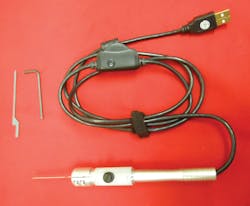Keedex has something new for reading wafer locks - a method of determining the depths of cut without removing or disassembling a lock. The Keedex USB Wafer Reader is a specialty digital camera that connects to a computer to provide an image of the lock face, keyway and the ledge positions of the wafers. Having a large image makes reading the wafer tumblers much easier. In addition, still and video images can be saved for comparison and future reference.
The Keedex Wafer Reader adjustable focal length camera resolution is two mega pixels. Because the Wafer Reader is an electronic device, the magnification is dependent upon the size of the display. The larger the display, the greater the apparent magnification is. Magnification using a 17” monitor is approximately 150X. The resolution of this camera’s images is 640 wide by 480 high pixels and the image size is 8.889” by 6.667” at 72 dots per inch. When shooting video, the display speed is 30 frames per second, which is the video standard in the United States.
The camera is approximately five inches long and approximately ½” diameter. The camera is normally connected to a laptop or netbook computer using an attached four-foot USB cable. No additional power is required; the USB cable provides the power source. (Contact Keedex for hardware requirements.)
This lightweight video clip and still image camera is equipped with an adjustable LED for illumination and a probe assembly to locate the focal point and manipulate the object being viewed. The intensity of the LED is adjustable to provide sufficient lighting for viewing the wafer tumblers within the keyway of the lock.
Operating the camera is relatively simple. With the computer up and the software running, the display provides a magnified image. To focus the camera, place the tip of the probe against a printed page. Because of the high magnification, the focal point is very small and must be accurately set. A printed page provides good contrast in order to have an image that is very sharp. Adjust the focus screw on the rear of the camera while viewing the image on the computer screen. The camera is in adjustment when the image of the print edge is sharp.
This way the camera’s focal length is set at the tip of a probe. When reading the wafers, place the tip of a probe against each wafer being read. A probe is secured to the camera assembly using two setscrews. To change a probe, use a 1/8” hex wrench. Always adjust the focal length after changing to a different probe.
The camera is equipped with an LED (Light Emitting Diode) whose intensity can be adjusted to maximize viewing. An adjustment wheel for the LED is built into the USB cable. Once the camera is in focus, insert the probe into the keyway and adjust the LED in order to read the wafer tumblers.
When reading the wafer tumblers, there are several important points to consider. Most importantly, the lock must be securely attached. If the lock can be shifted, the wafers can be more difficult to keep in focus.
Another important point is to know the lock. How many wafers are in the lock? How many depths of cut? Do some or all of the wafers have a number stamped into the face? The number will most often be stamped above the window. Is the lock single throw, meanin all of the wafers move in the same direction, or is the lock double throw, where adjacent wafers move in opposite directions? If the lock is double throw, the likelihood is half of the wafers that have a depth of cut stamped will not be visible as the wafers are positioned 180 degrees to accommodate their springs.
To read a wafer lock, place the probe into the keyway. If the lock is equipped with a shutter unit, use a turning tool to keep the shutter open. Use a pick to determine that the number of wafers in the lock agrees with the manufacturer’s information.
The wafer tumblers are usually read from back to front, depressing all of the wafers. Slide the probe forward slightly in order to see only the rear most wafer. Look for a depth number possibly stamped into the wafer. Depending upon the wafer tumbler manufacturer, the number may be positioned vertically, the same as the direction the wafer tumblers move or they may be positioned horizontally. Some manufacturers use both positions for different depth wafers. If the wafers have depth numbers, the job is simplified.
If not, the depths of cut can be determined by reading the height of each wafer tumbler’s ledge in the “rest” position. The probe is used to provide visual access to the wafer tumblers being read, keep the forward wafer tumblers depressed, as well as determining the focal length. Once the rear tumbler has been read, pull the probe forward to release only the next wafer tumbler. Read this wafer tumbler. Continue pulling the probe slowly forward until all of the wafer tumblers have been read.
Note: Use previously read wafer tumbler positions at rest to help gauge the visible forward positioned wafer tumblers. Sometimes the forward wafer is lower in the at rest position, which can help to determine the depth of cut for both.
Originate a key using either the determined depths of the cuts or use half cuts when uncertain. Half cuts provide more depth of cut options, which can be helpful.
The purpose of reading a wafer tumbler lock is to open the locked cabinet, desk, etc. Once the lock operates once, the actual depths can be determined by using basic impressioning methods.
The Keedex stock number is USB-WR.
For more information, contact your local locksmith distributor or Keedex, 510 Cameron St., Placentia, CA 92870. Telephone :714-993-4300. Web Site: www.keedex.com.






